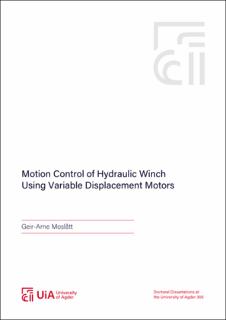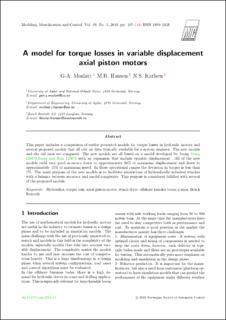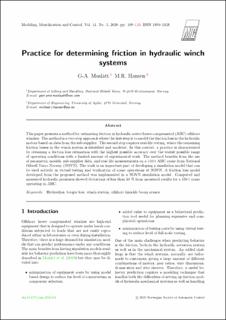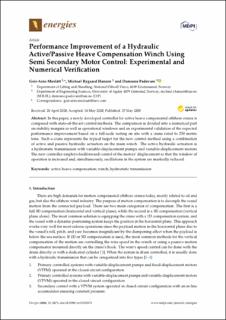| dc.contributor.advisor | Meisfjordskar, Anders | |
| dc.contributor.advisor | Hansen, Michael Rygaard | |
| dc.contributor.advisor | Padovani, Damiano | |
| dc.contributor.author | Moslått, Geir-Arne | |
| dc.date.accessioned | 2020-12-01T22:12:33Z | |
| dc.date.available | 2020-12-01T22:12:33Z | |
| dc.date.issued | 2020 | |
| dc.identifier.citation | Moslått, G.-A. (2020). Motion Control of Hydraulic Winch Using Variable Displacement Motors (Doctoral thesis). University of Agder, Kristiansand. | en_US |
| dc.identifier.isbn | 978-82-8427-008-1 | |
| dc.identifier.issn | 1504-9272 | |
| dc.identifier.uri | https://hdl.handle.net/11250/2711317 | |
| dc.description | The paper II is excluded from the dissertation with respect to copyright. | |
| dc.description.abstract | To compete in the open market of the offshore crane industry, it is imperative for the manufacturer to continuously improve crane operability. In this context, the crane operability is expressed by means of a so-called weather window. The weather window is computed from the crane characteristics in combination with that of the vessel and the payload to be handled. It returns a set of boundaries for when it is accepted to perform a planned lift, mainly in terms of current sea-state and wind. The most important crane operability characteristics that enter into the computation of the weather window are maximum wire velocity and load capacity.
This thesis focuses on how to improve the operability of active heave compensated offshore cranes. Two ways of achieving that goal have been investigated, namely, an improved control strategy and the use of model-based lift planning.
The system investigated is the hydraulic active/passive winch system used by National Oilwell Varco. A new control strategy for the system was developed, tested, and implemented. The new strategy utilizes that variable displacement of the hydraulic motors of the active system of the winch drive. The strategy, semi secondary control, gave significant benefits in terms of reduced peak-pressure, increased load capacity, increased wire-speed capacity, and smoother winch performance at low winch speed. The results were validated and verified through simulations and in-field measurements. | en_US |
| dc.language.iso | eng | en_US |
| dc.publisher | 07 Media | en_US |
| dc.relation.ispartofseries | Doctoral Dissertations at the University of Agder; no. 305 | |
| dc.relation.haspart | Paper I: Moslått, G.-A., Hansen, M. R. & Karlsen, N. S. (2018). A model for torque losses in variable displacement axial piston motors. Modeling, Identification and Control, 39(2), 107-114. http://dx.doi.org/10.4173/mic.2020.2.6. Published version. Full-text is available in AURA as a separate file: . | en_US |
| dc.relation.haspart | Paper II: Moslått, G.-A. & Hansen, M. R. (2018). Modeling of Friction Losses in Offshore Knuckle Boom Crane Winch System. In 2018 Global Fluid Power Society PhD Symposium. IEEE. http://dx.doi.org/10.1109/GFPS.2018.8472316. Published version. Full-text is not available in AURA as a separate file. | en_US |
| dc.relation.haspart | Paper III: Moslått, G.-A., Padovani, D. & Hansen, M. R. (2019). A Control Algorithm for Active/Passive Hydraulic Winches Used in Active Heave Compensation. In ASME/BATH 2019 Symposium on Fluid Power and Motion Control. ASME Press. https://doi.org/10.1115/FPMC2019-1710. Published version. Full-text is not available in AURA as a separate file. | en_US |
| dc.relation.haspart | Paper IV: Moslått, G.-A. & Hansen, M. R. (2020). Practice for determining friction in hydraulic winch systems. Modeling, Identification and Control, 41(2), 109-120. https://doi.org/10.4173/mic.2020.2.6. Published version. Full-text is available in AURA as a separate file: . | en_US |
| dc.relation.haspart | Paper V: Moslått, G.-A., Hansen, M. R. & Padovani, D. (2020). Performance Improvement of a Hydraulic Active/Passive Heave Compensation Winch Using Semi Secondary Motor Control: Experimental and Numerical Verification. Energies, 13(10), 109-120. https://doi.org/10.3390/en13102671. Published version. Full-text is available in AURA as a separate file: . | en_US |
| dc.relation.haspart | Paper VI: Moslått, G.-A., Padovani, D. & Hansen, M. R. (2020). A digital twin for lift planning with offshore heave compensated cranes. Journal of offshore Mechanics and Arctic Engineering, 143(3). https://doi.org/10.1115/1.4048881. Published version. Full-text is not available in AURA as a separate file. | en_US |
| dc.title | Motion Control of Hydraulic Winch Using Variable Displacement Motors | en_US |
| dc.type | Doctoral thesis | en_US |
| dc.description.version | publishedVersion | en_US |
| dc.rights.holder | © 2020 Geir-Arne Moslått | en_US |
| dc.subject.nsi | VDP::Teknologi: 500 | en_US |
| dc.source.pagenumber | 148 | en_US |
| dc.source.issue | 305 | en_US |
| dc.identifier.cristin | 1854954 | |



